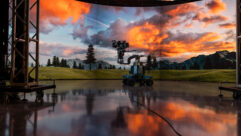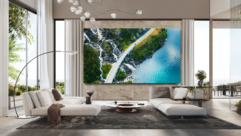
Picture This: Technology on Display
May 1, 2007 12:00 PM,
By Jeff Sauer
Looking back at NAB revelations and ahead to potential InfoComm innovations.

NAB 2007 featured high-quality display debuts from several companies, including Sony, JVC, and Teranex.
Displays at NAB tend to have a fairly narrow focus. Most are elite products that target image-critical applications more than the general-purpose or public display products shown at InfoComm. Yet those high-quality products do afford a look at how far the technology has come and offer a glimpse at what will ultimately migrate down into a broader range of products over the coming months and years.
At NAB 2007, LCD technology again made great strides. Last year, Panasonic introduced the production-quality BT-LH2600W, the 26in. LCD reference monitor that improved on the design and features of the 17in. BT-LH1700W. This year, Panasonic expanded that line-up of reference monitors with the smaller 7.9in. BT-LH80W ($2,700, available in June). Available either separately or in a multi-monitor rack configuration, the diminutive LH80W has a native resolution of just 800×450, but shares the LH2600’s pixel-to-pixel mode for scrutinizing images, as well as the feature Focus-in-Red for live camera work.
JVC added a 20in. and 24in. LCD to its line of professional broadcast monitors. The DT-V20L1DU ($3,495) features a somewhat odd 1680×945 native resolution, while the DT-V24L1DU ($4,695) is native 1920×1080, although both can display everything up to 1080p. They also both have digital SDI and HD-SDI inputs and support exacting backlight color temperature control, as well as blue-check and grayscale modes.
Sony’s line of professional Luma LCD production monitors was also revamped for NAB 2007 with several new models in a variety of sizes. More impressively, Sony introduced an LED-backlit LCD reference monitor under a new brand, TriMaster. The TriMaster BVM-L230 won’t be available until this fall and will carry a hefty price tag of about $25,000, but Sony’s clearly positioning itself as the industry leader. Sony’s booth featured a blind side-by-side comparison of two new TriMaster BVM-L230s and one CRT-based BVM-F24U CineAlta mastering monitor, the erstwhile reference standard, and differences were tough to spot. I overheard several onlookers who couldn’t tell the difference. A few correctly picked out the CRT, but even those seemed to agree that one technology wasn’t necessarily better — just that there were subtle differences. Sony expects to expand the TriMaster line with other sizes, including a 42in. panel, by year’s end.
Sony’s Sunday press conferences are becoming increasingly devoid of real news, but this one did open with a surprisingly impressive 3D demonstration of footage from this year’s NBA All-Star game. The game, played in Las Vegas this past February, was shot in high-definition (19201×080) 3D by Pace Micro Technology, and was shown on a pair of polarized Sony 4K SXRD digital cinema projectors. Yes, the demonstration still requires the darn polarizing glasses, but the realism of HD combined with 3D made for an impressive display that ultimately showed some serious potential business opportunities for 3D production. Try to see this demonstration if Sony brings it to InfoComm.
JVC also had an in-booth 3D demonstration that was, on the surface, very uninspired and really of poor quality. However, the technology was fascinating: JVC was showing the ability to record both channels of stereo high-definition 3D from side-by-side camcorders to a standard HD tape. Novelty? Perhaps, but after Sony’s HD 3D demo, it’s worth watching JVC’s progress, or at least how JVC exploits the technology.
Teranex, a brand of Silicon Optix, introduced the two-piece ClearVue 24in. LCD monitor system ($4,799). The input module for the ClearVue is a rackmountable unit with everything from SD/HD-SDI to DVI, to analog component, composite, and S-Video. It also includes the Silicon Optix HQV Realta image-processing chipset.
Want bigger, higher resolution? Barco and Astro Systems were showing a new 56in. LCD panel with a native 4K (3840×2160) resolution. Both panels were OEMed from the same Asian manufacturer, but Barco and Astro were targeting different applications. Astro sees the 4K panel as an ultra HD display monitor for post and broadcast, while Barco eyes integrating it into multi-window control rooms.
CONVERGING AND CONVERTING
Scan converters solve specific broadcast problems, and TV One’s new 1T-C2-511 has a utilitarian name and function: converting SD/HD-SDI video into DVI or analog RGBHV. TV One’s conversion, if necessary, includes de-embedding SDI-embedded audio into either analog or AES3 digital audio.
At least a couple of companies were offering scan converters that go the other way. Communications Specialties (CSI) is finally shipping its Scan Do HD DVI-to-HD/SD-SDI scan converter, announced last year. It can handle up to 19201×080, but it can also handle a variety of resolutions using 10-bit processing for a clean signal. And, because it’s CSI, the Scan Do HD has a fiber-optic output port.
And Analog Way also introduced the BroadScan HD family of scan converters. Analog Way will offer both analog and digital versions with prices ranging from $4,795 to $7,950. Depending on the model, they will accept either a 15-pin RGB or DVI signal and convert it to either analog or HD/SD-SDI digital output. All models feature a unique 1000-percent zoom that allows you to highlight specific areas of an image and display them at fullscreen. And there’s a luma-key output feature for building a custom key on a computer and using it directly with a live feed.
Of course, both the BroadScan HD and Scan Do HD products focus on the computer-to-video conversions of the broadcast industry more than the wider-ranging conversion needs of products that will be at InfoComm. There will be several, including a new line of very high-quality universal upconverters and downconverters under the name OptimizerHD that will significantly improve even standard-definition TV images for display on very large or wide screens.
Not everything at NAB was strictly broadcast-oriented. Barco introduced two new models to its iCon family of intelligent meeting room projectors. The 2500-lumen iCon H250 and 4000-lumen iCon H400 actually have the same $24,495 price and same lamp. The difference is in the color wheels. The brighter H400 has a four-segment RGB-plus-white color wheel for presentation and business use, while the H250 has a six-segment RGBRGB wheel for color-centric image and video viewing applications. Similar to other iCons, both are bestowed with an Intel Pentium processor and Windows XP Professional operating system, allowing the projectors to not only display business documents and browse the Web without a computer attached, but also, more importantly, to interact with other devices on a network and the Internet.
It’s this collaborative workflow that Barco highlighted at NAB, and it should have much broader appeal to the professional AV industry as well. At NAB, Barco connected a simple webcam to one of the picture-in-picture inputs and showed how remote collaborators could see the exact same images, shared by two iCons over a network, as well as insets of their own faces. Barco’s multi-window, multi-in, multi-out, XDS-1000 platform, announced late last year, adds even more simultaneous inputs and windowed outputs. Look for Barco to take this collaborative display technology to the next level at InfoComm with partners across the show floor.
And, although perhaps a little odd for NAB, Electrosonic programmed a Bluetooth-enabled FrEND (Far End Networked Device) to read retail tags on a rack full of women’s dresses and immediately play back a video clip of a model wearing the exact dress. It’s a clever use of the technology and just a hint of the innovative digital signage ideas I’d like to see at InfoComm.










